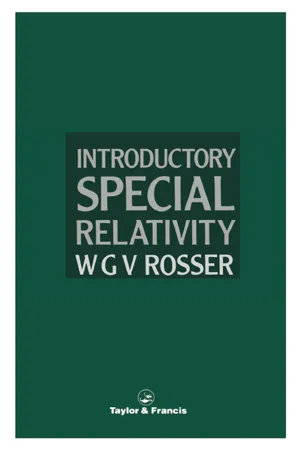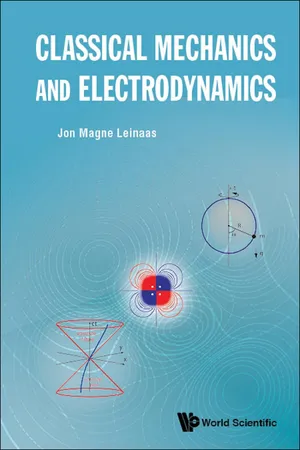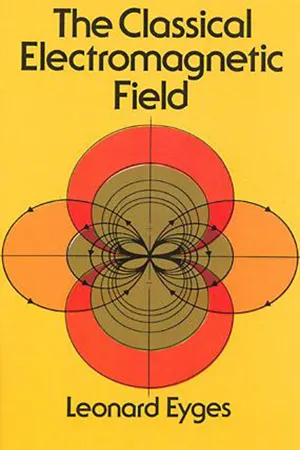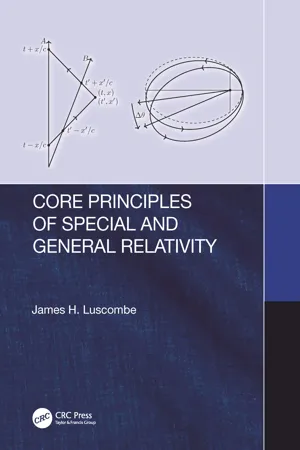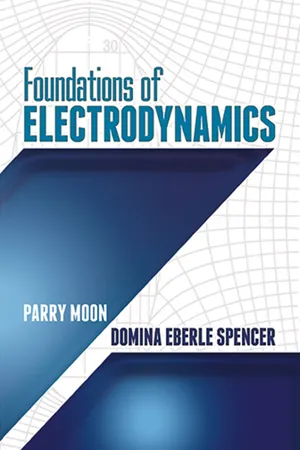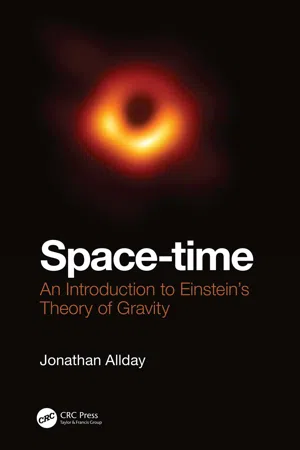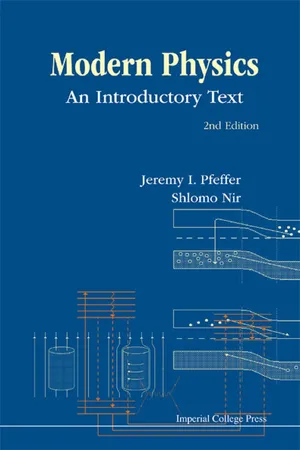Physics
Galilean Transformation
The Galilean transformation is a set of equations that relate the coordinates of an event as measured in one inertial frame to the coordinates measured in another inertial frame moving at a constant velocity relative to the first. It forms the basis for classical mechanics and describes how space and time coordinates transform between different inertial reference frames.
Written by Perlego with AI-assistance
Related key terms
Related key terms
1 of 4
Related key terms
1 of 3
12 Key excerpts on "Galilean Transformation"
- eBook - ePub
- Michael M. Mansfield, Colm O'Sullivan(Authors)
- 2020(Publication Date)
- Wiley(Publisher)
transformation.Inertial reference frames
An inertial reference frame is a frame in which Newton's first law of motion holds. In such a frame, any body which is in a state of rest or of uniform motion (that is, constant velocity, which may be translational, rotational or both) continues in that state without change of translational or angular velocity. Thus we see that Newton's first law provides a practical test of whether Newton's second law applies. We can therefore state thatIt follows that the general conservation principles (of momentum, angular momentum, and energy) also apply in inertial frames because they are derived directly from Newton's laws.Newton's second law of motion applies only in inertial reference frames.8.2 The Galilean Transformation
A common practical requirement is the conversion of the coordinates of a point, as measured in one reference frame, to the coordinates of the same point, as measured in a second reference frame which is moving with constant velocity relative to the first. The equations which are used to achieve this conversion are known as the Galilean Transformation (Galileo Galilei,1564–1642) and are derived below.(a) The coordinates of a point P in the x—y plane as viewed from a fixed reference frame K (coordinate system (x, y)) and from a frame K′ (coordinate system (x′, y′)) which is moving with velocity v along the x‐axis of the fixed system. (b) The Galilean displacement transformation of the displacement of P from the moving system to the fixed system, namelyFigure 8.3r = r′ + vt.Consider the two reference frames, K and K′ (Cartesian coordinate systems), as illustrated in Figure 8.3 . The second frame, which has axes x′, y′ and z′, is moving so that its origin, O′, is moving at constant velocity, v, along the x‐axis of the first frame, which has axes x, y and z. The x′‐axis of the second frame lies along the x‐axis of the first frame. If the coordinates of an event are (x, y, z, t) and (x′, y′, z′, t′), respectively, in the two frames and if the origins of the two frames, O and O′, coincide att = t′ = 0, we can, by inspecting Figure 8.3 - eBook - ePub
- W G V Rosser(Author)
- 2017(Publication Date)
- CRC Press(Publisher)
υ relative to ∑. Conversely, the Galilean Transformations are the appropriate coordinate and time transformations if Newton’s laws of motion obey the principle of relativity—that is, if Newton’s laws hold in all inertial reference frames.REFERENCEKibble, T.W.B. (1985) Classical Mechanics, 3rd edn. Longman, London.PROBLEMS 1.1 If you were locked in the hold of a ship, how would you prove that the ship was (a) moving with uniform velocity, (b) accelerating relative to the Earth?1.2 A ship is travelling due east at a speed of 25 m s−1 .(a) A ball is rolled due north on the deck of the ship at a speed of 5 m s−1 relative to the ship. What is its velocity relative to the Earth?(b) If the ball is rolled 30° east of north at a speed of 5 m s−1 relative to the ship, what is its speed relative to the Earth?1.3 A stone is dropped from rest from the mast of a ship moving with a velocity of 15 m s−1 relative to the Earth. Choose the origins of ∑ (the laboratory frame) and ∑′ (the coordinate system in which the ship is at rest) such that these origins both coincide with the stone at the instant t = 0 when the stone is dropped. If the acceleration due to gravity is 9.8 m s−2 , find the position of the stone (a) relative to the ship, (b) relative to the laboratory frame after 2 s. Show how the results can be related using the Galilean Transformations. The ship is moving parallel to the x axis of ∑.1.4 Assume that at time t the two ends of a moving rod are at (x1 , y1 , z1 ) and (x2 , y2 , z2 ) in the inertial reference frame ∑, so that the length of the rod in ∑ is [(x2 − x1 )2 + (y2 − y1 )2 + (z2 − z1 )2 ]1/2 . Use the Galilean Transformations to determine the coordinates of the ends of the rod at time t′ = t in an inertial reference frame ∑′ that is moving with uniform velocity υ relative to ∑ along their common x axis. The origins of ∑ and ∑′ coincide at t = t′ - eBook - ePub
- Jon Magne Leinaas(Author)
- 2018(Publication Date)
- WSPC(Publisher)
v is then given bywith (x, y, z, t) as the position and time coordinates in the first inertial reference frame (S) and (x′, y′, z′, t) as the corresponding coordinates in the second frame (S′). These are the coordinate transformations used in elementary physics (and implicitly also in every day life), and to specify that the time coordinate is the same in the two reference frames seems almost unnecessary. Assume now a small body moves with velocity relative to reference frame S, and velocity relative to reference frame S′. The coordinate transformation (4.1 ) then gives us the standard velocity transformation formulaThe transition from one inertial system to another means simply to correct the velocities by adding or subtracting the relative velocity of the two reference systems. This situation is illustrated in Fig. 4.1 with the two sets of orthogonal coordinate axes representing the inertial frames. The transformation formula clearly shows that a theory which contains a velocity as constant parameter cannot be invariant under Galilean Transformations.Fig. 4.1Transition from one inertial frame S to another S′, illustrated by two coordinate systems in relative motion along the x-axis. The velocity u of a particle P and and the velocity v of the reference frame S′ are given relative to reference frame S. The Galilean Transformation between S and S′ determines the velocity u′ of the particle P in S′, by subtraction of the relative velocity v of the two reference frames, u′ = u – v. In special relativity this rule for transforming velocities is no longer valid.The Lorentz transformations, which give the correct relativistic formula for the transition between two inertial frames S and S′ iswhere γ is defined aswith v - eBook - ePub
Quantum Non-Locality and Relativity
Metaphysical Intimations of Modern Physics
- Tim Maudlin(Author)
- 2011(Publication Date)
- Wiley-Blackwell(Publisher)
We will not immediately attack this problem head on. Instead, we will return for a moment to the classical realm, and to the classical analog of Lorentz invariance, namely Galilean invariance. The reason for this is twofold. First, Galilean invariance is a simpler and more tractable formal property, and so provides a good training ground to develop some of the technical machinery. But second, and perhaps more important, Galilean invariance does not display some of the fundamental properties of Lorentz invariance. So intuitions honed on the Galilean case, as the intuitions of most students of physics are, can be quite deceptive if transferred to the arena of Special Relativity. It will be easier to point out these disanalogies, and so to avoid them, if we have studied the classical case first.Galilean Transformations and Galilean InvariantsThe inertial frames of classical physics are coordinate systems with two properties. First, at any given moment, space is coordinatized by a rectangular Cartesian grid. Second, each of the spatial coordinates on the grid follows an inertial (i.e. straight) trajectory through the space-time. (It is really only this second property which makes the frame inertial.) Suppose we have two such frames, primed and unprimed, which exactly coincide at t = t′ = 0, such that the primed frame is moving at a constant speed v with respect to the unprimed frame. For simplicity, we imagine that the unprimed frame is moving in the positive x-direction. Then the equations which give the location of a point in the primed coordinates in terms of its location in the unprimed coordinates are:This is a Galilean Transformation.If a physical theory respects the Galilean Transformations then it will take the same form in all inertial coordinate systems. Physically, this means that none of the inertial frames is preferred over any other, so there is no “absolute space” or “absolute velocity.” Different coordinate systems will attribute different velocities to a particle but none will be any more “correct” or “true” than any other.It is instructive to consider how a classical theory might achieve Galilean invariance. The most obvious route is through quantities which are themselves invariant under the Galilean Transformations. For example, although velocities are changed under such a transformation, acceleration (change in velocity) is not, for if we add the same constant term to two velocities their difference remains unchanged. Newtonian gravitational theory achieves Galilean invariance by this means. The fundamental dynamical law of Newtonian mechanics is F = ma. The acceleration a, as we have seen, is Galilean invariant. So too is the inertial mass m in Newtonian theory. So the necessary and sufficient condition for any Newtonian theory to be Galilean invariant is that the force F be the same in all inertial frames. The Newtonian gravitational force G = GmM/r2 - eBook - ePub
- Leonard Eyges(Author)
- 2012(Publication Date)
- Dover Publications(Publisher)
absolute time that is inherent in them and that was overthrown by the special theory.12.2 GALILEAN RELATIVITY AND ABSOLUTE TIME
Galilean Transformations are certain mathematical (as opposed to physically verifiable) relations between the coordinates x, y, z and the time t of a point or particle in one coordinate system and x′, y′, z′, t′ for the same point or particle in a system moving with uniform velocity with respect to it. Figure 12.1 illustrates an unprimed system and a primed system that move in the relative x -direction with velocity ν. Suppose that the relation between the x -coordinate and the x′ -coordinate is the “obvious” one, x′ = x − υt, that the y and z coordinates are unchanged on transformation, and that the times, t and t′ , are identical. These various relations constitute the Galilean transformation:(12.3)Fig. 12.1 Coordinate systems with relative velocity υ.The equation t′ = t is innocent in appearance, but let us consider it in more detail. It says that the measure of time is the same in the primed and the unprimed system. This time, common to the two systems and, of course, to any of the infinite number of others in relative uniform motion, is Newton’s absolute time. This concept of absolute time is, roughly, that of some super master clock whose readings can be transmitted instantly to any or all experimenters in any or all uniformly moving frames of reference. However, no such clock exists, so we shall have to define absolute time from a more operational viewpoint. We proceed in three steps: First, we define time at one point of a given reference frame; second, we define a time common to different points of the same reference frame; and third, we define a time common to uniformly moving - James Luscombe(Author)
- 2018(Publication Date)
- CRC Press(Publisher)
If time is included as a separate dimension, however, r ′ = r − v t and t ′= t can be expressed as a linear transformation in four-dimensional spacetime: (t ′ x ′ y ′ z ′) = (1 0 0 0 − v x 1 0 0 − v y 0 1 0 − v z 0 0 1) (t x y z). (Galilean Transformation) (1.3) Let’s get in the habit of listing the time “coordinate” first, 26 as in Eq. (1.3). Equation (1.3) is the Galilean Transformation (GT), the form of relativity based on everyday experience. Despite its common-sense appeal, the GT does not lead to predictions in agreement with experiment; 27 it will be replaced by another linear transformation of spacetime coordinates that does lead to agreement with experiment—the Lorentz transformation (LT). 28 1.2.4.4 Form invariance The idea of form invariance can be illustrated using the GT, because acceleration is invariant under that transformation: a ′ ≡ (d 2 / d t ′ 2) r ′ = (d 2 / d t 2) (r − v t) = (d 2 / d t 2) r = a. Observers in S and S ′ agree on the form of Newton’s second law: F ′ = m a ′ = m a = F, where mass is the same in all IRFs. 29 The laws of mechanics are invariant under the GT. What about electromagnetism? Maxwell’s equations predict the existence of electromagnetic waves that propagate with a speed given in terms of electromagnetic parameters, c = 1 / ϵ 0 μ 0. It’s shown in Appendix A that the wave equation transforms under the GT for frames in relative motion along a common x -axis as: ∂ 2 ∂ x 2 − 1 c 2 ∂ 2 ∂ t 2 = (1 − v 2 / c 2) ∂ 2 ∂ x ′ 2 − 1 c 2 ∂ 2 ∂ t ′ 2 + 2 v c 2 ∂ 2 ∂ x ′ ∂ t ′. (A.3) Form invariance therefore does not hold for the wave equation under the GT, implying a crack in the foundation of physics. The inconsistency is that Maxwell’s equations are fundamental laws of physics, yet a prediction of those equations is not invariant under the GT, while the laws of mechanics are. Let’s consider the three possible explanations for this inconsistency: 1. The principle of relativity applies to mechanics, but not to electromagnetism- eBook - ePub
- Hermann Weyl(Author)
- 2013(Publication Date)
- Dover Publications(Publisher)
C′. Thus, in mechanics, any two “allowable” co-ordinate systems are connected by formulæin which the aik's are constant co-efficients of an orthogonal transformation, and a, ai and γiare arbitrary constants. Every transformation of this kind represents a transition from one allowable co-ordinate system to another. (This is the Principle of Relativity of Galilei and Newton.) The essential feature of this transition is that, if we disregard the naturally arbitrary directions of the axis in space and the arbitrary initial point, there is invariance with respect to the transformationsIn our graphical representation (vide Fig. 7 ) x′1 , x′2 , t′ would be the co-ordinates taken with respect to a rectilinear set of axes in which the x′1 -, x′2 - axes coincide with the x1 , x2 - axes, whereas the new t′- axis has some new direction. The following considerations show that the laws of Newtonian mechanics are not altered in passing from one co-ordinate system C to another C′. According to the law of attraction the gravitational force with which one point-mass acts on another at a certain moment is a vector, in space, which is independent of the co-ordinate system (as is also the vector that connects the simultaneous positions of both point-masses with one another). Every force, no matter what its physical origin, must be the same kind of magnitude; this is entailed in the assumptions of Newtonian mechanics, which demands a physics that satisfies this assumption in order to be able to give a content to its conception of force. We may prove, for example, in the theory of elasticity that the stresses (as a consequence of their relationship to deformation quantities) are of the required kind.Mass is a scalar that is independent of the co-ordinate system. Finally, on account of the transformation formulæ that result from (1) for the motion of a point-mass,not the velocity, but the acceleration is a vector (in space) in-dependent of the co-ordinate system. Accordingly, the fundamental law: mass times acceleration = force, - eBook - ePub
- A. L. Stanford, J. M. Tanner(Authors)
- 2014(Publication Date)
- Academic Press(Publisher)
They permit us to make calculations that relate positions and times as measured in reference frames that are moving relative to each other. E 22.5 Show that the Lorentz transformation reduces to the Galilean Transformation for v c. E 22.6 Event A is observed in frame S to occur at x = 2700 km on the x axis and at t = 0, that is, S observers determine that event A is simultaneous with the t = t′ = 0 coincidence of the origins of S and S′. Let v x = 0.80 c. (a) Where does event A occur S′ ? Answer: x′ A = 4500 km (b) When does event A occur in S′. Answer: t′ A = −12 ms E 22.7 Consider again the two events of Exercise 22.6. Recall that since both events occur at t = 0, S observers conclude that the events occur simultaneously. (a) Are the two events also simultaneous in S′ ? Answer: No. (b) Which event occurs first in S′ ? Answer: Event A occurs 12 ms before the two origins coincide. Example 22.1 PROBLEM What conditions, if any, ensure that if two events are simultaneous in one inertial frame, these events will be simultaneous in other inertial frames? SOLUTION Suppose events A and B are specified in frame S by (x A, y A, z A, t A) and (x B, y B, z B, t B). The times for these events in any other frame S′ are given by t ′ A = γ (t A − v x x A / c 2) t ′ B = γ (t B − v x x B / c 2) Thus the time interval, Δ t′ = t′ B – t′ A, in S′ is related to the time interval, Δ t = t B –. t A, in S by Δ t ′ = t ′ B − t ′ A Δ t ′ = γ (t B − v x x B / c 2) − γ (t A − v x x A / c 2) Δ t ′ = γ (t B − t A) − γ v x (x B − x A) / c 2 Δ t ′ = γ Δ t − γ[--=PLGO-SE. PARATOR=--]v x Δ x / c 2 where Δ x = x B – x A is the x separation in S of events A and B. If now A and B are simultaneous events in S, that is, if Δ t = 0, then Δ t ′ = γ v x Δ x / c 2 And the two events will be simultaneous in S′, that is, Δ t′ = 0, if and only if Δ x = 0 - eBook - ePub
- Parry Moon, Domina Eberle Spencer, Domina Eberle Spencer(Authors)
- 2013(Publication Date)
- Dover Publications(Publisher)
11-02. Transformations. There is no loss of generality in taking the z and z′ axes in the direction of v. Also take t = t′ = 0 at the instant when the origins O and O′ pass each other.The Galilei transformation is This is the ordinary, common-sense transformation, which is so familiar that we use it without thinking.But a more general transformation is desired. What is the most general transformation that will satisfy the postulates of Section 11-01 ? Since the location of an event requires four numbers—three to designate location in space, one to fix the time—we are dealing (whether we like it or not) with a transformation in 4-space. For the coordinates (x1 , x2 , x3 , x4 ) of a point in 4-space (Postulate ), let us takeThe superscripts do not denote powers, of course, but are merely the conventional labels or indices of tensor notation.4The most general transformation, linear in distance and time (Postulate ), isEquation (11-01) shows that the transformation will contain v as a parameter, so we have allowed the coefficients aij to be functions of velocity. For any given transformation, of course, aij will be constants, since the motion is unaccelerated and therefore v is not a function of time. For the special case of the Galilei transformation, the coefficients of Eq. (11-02) reduce to a11 = a22 = a33 = 1, a34 = iv/c0 , and all the others are zero.According to Postulate ,and a31 = a32 = a41 = a42 = 0. Thus all but four of the coefficients aij are determined and only two equations need be considered:The problem now is to evaluate the four coefficients aij (v).11-03. Evaluation of Coefficients. As a first step,2 reverse the direction of the z-axis. Then x3 , x3 ′ , and v are changed in sign but x4 is unchanged. SoComparison of Eqs. (11-03) and (11-04) shows thata33 (v) and a44 (v) are even functions,a34 (v) and a43 (v) are odd functions of v.Now return to the original coordinate systems. As a special case, take the point O - force. The above principle of relativity of motion accommodates the fact that in Newtonian mechanics, velocities are relative but accelerations – the rate of change of velocity – are absolute, i.e., are the same regardless of whether an observer is at rest or in uniform motion. Newton himself regarded accelerative motions as motions referred to a background absolute space and time, and only derivatively motions with respect to other bodies. In its modern form, Corollary V is known as the relativity principle of mechanics, or the “Galilean Principle of Relativity”. It states,[n]o mechanical experiment can distinguish between a “rest frame” S and a frame S’ moving relatively to S with a uniform inertial (rectilinear) motion.The most advanced theory when Einstein initiated his studies of physics was no longer mechanics but an electrodynamics derived from Maxwell’s equations of electromagnetism. However Maxwell’s equations did not obey the Galilean Transformation relations between inertial frames as in Newtonian mechanics. To many physicists this was not an issue worth troubling over. Maxwell, after all, had shown that electromagnetic phenomena propagate through space as waves, a decidedly non-mechanical motion. Already a convinced adherent of the inherent reasonableness of the relativity principle, Einstein in 1905 showed how the Galilean principle above can be generalized to apply to the phenomena of electrodynamics, affirming the principle of relativity (in slightly modernized language):[t]he laws of physics (mechanics and electrodynamics) are the same in every inertial frame.Others, such as H.A. Lorentz and Henri Poincaré, sought to implement a relativity principle in electrodynamics through various hypothetical models of the electron. Such models generally retained a privileged inertial frame, a rest frame in which the velocity of light is constant. Einstein correctly judged the state of physical theory premature for attempting detailed accounts of the forces acting on the microconstituents of moving measuring rods and clocks, instruments required for the definition of an inertial frame. Instead he legislated a sharp separation between kinematics (pertaining to generic structural features of the notions of space, time, and motion) and dynamics
- eBook - ePub
Space-time
An Introduction to Einstein's Theory of Gravity
- Jonathan Allday(Author)
- 2019(Publication Date)
- CRC Press(Publisher)
2.6 into Equation 2.7. This might seem to be a hopeless quest as, in principle, the transformations could be anything. However, there are some assumptions that help us out: the y and z co-ordinates should be unchanged, as they will be perpendicular to the direction of relative motion between the systems; the transformations should be linear, which means no powers of x or t involved; the transformation between t and t ′ must be a function of x (as suggested earlier), so presumably the transformation between x and x ′ will be a function of t. The linearity condition cuts down the possibilities dramatically. It is a sensible assumption as without it, an object travelling in a straight line in one system could well travel along a curved path in another… (a bit of a hint as to how gravity might work here for the future…). On this basis, we write the transformations as: x ′ = a x + b t t ′ = A t + B x y ′ = y z ′ = z, where the constants a, b, A, B have to be figured out. We might also note that in this linear form there is the hope that the transformations will be consistent with the Galilean ones we derived earlier, at least at speeds that are not large fractions of light speed. To obtain the constants, we note that the origin of the moving system (x ′ = 0) is passing along the x -axis and that it is sensible to set t ′ = t = 0 as the origins coincide. Hence, for times after that crossing, the origin of the moving system must be at a point in the stationary system, x, such that x = v t. This tells us that if: x ′ = a x + b t then 0 = a v t + b t, so that b = − a v, giving: x ′ = a x + b t = a x − a v t = a (x − v t). The next step is to drop our fledgling transformations into Equation. 2.7 : (a (x − v t)) 2 + (y) 2 + (z) 2 = c 2 (A t + B x) 2. Multiplying things out gets a bit messy, but we are made of stern stuff so: a 2 (x 2 − 2 x v t + v 2 t 2) + y 2 + z 2 = c 2 (A 2 t 2 + 2 A B x t + B 2 x 2). Gathering terms together - eBook - ePub
Modern Physics
An Introductory Text
- Jeremy I Pfeffer, Shlomo Nir(Authors)
- 2012(Publication Date)
- ICP(Publisher)
′ in that of observer S′. However, because of the constancy of the speed of light each observer must measure the same value for this velocity, i.e.Eliminating x, x′, t and t′ from Eqs (1.62) ,(1.63) and (1.64) givesThus, the factor of proportionality, k, derived from the postulates of special relativity, is identical to the factor γ that appears in the equations of the Lorentz transformation. The proposed transformation equations, (1.62) and (1.63) , are thus identical to the corresponding equations of the Lorentz transformation.1.4.7 Relativistic Mechanics — KinematicsThe essential feature of the relativistic mechanics is its compatibility with the Lorentz transformation. In the realm of kinematics, we will investigate how this affects the measurement of three physical quantities: distances (spatial displacements) and time intervals; and a new quantity called the space–time interval.1. The measurement of distances — length contractionUnder the classical Galilean Transformation, the measured size of an object is unaffected by the relative motion of inertial observers; distances and displacements are invariants. However, as we shall see, under the Lorentz transformation, both of these measures are relative quantities.Consider a rod, AB, that is at rest in the S reference frame (Fig. 1.29 ). The length of the rod, viz. the distance between the points A and B parallel to the XX′-axis, is measured by an observer in the reference frame S and by another in the moving frame S′ (Fig. 1.30 ). What is the relationship between the rod’s length, L0 , measured by the observer in frame S and its length, L, measured by the moving observer from the S′ frame?Fig. 1.30. Two points, A and B, marking the ends of a rod in the stationary reference frame S. The length of the rod according to the coordinate system S is L0 = x2 −x1 , and according to the coordinate system S′ is L = x′2 −x′1
Index pages curate the most relevant extracts from our library of academic textbooks. They’ve been created using an in-house natural language model (NLM), each adding context and meaning to key research topics.
Explore more topic indexes
Explore more topic indexes
1 of 6
Explore more topic indexes
1 of 4

